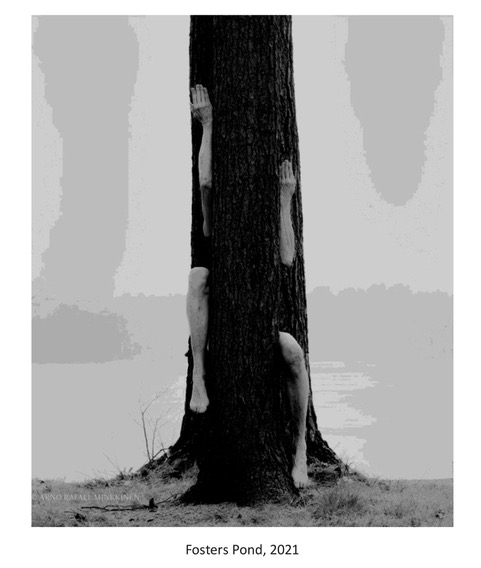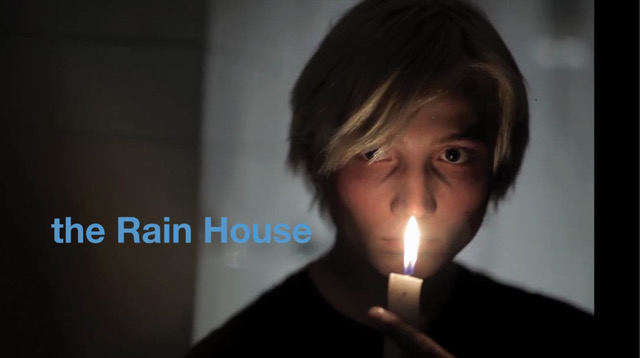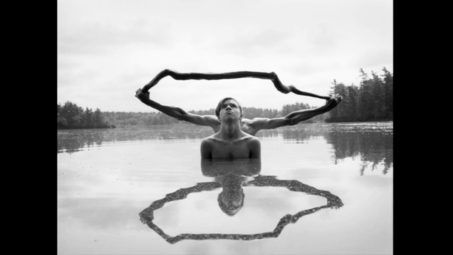Still Not There: An interview with Arno Rafael Minkkinen
He is a major photographic artist, exhibited internationally many times, collected by the greatest museums. Arno Rafael Minkkinen bares his world for DK2R in an exceptional first interview, a mix of aesthetic musings and personal reflections. All adorned with what Michel Tournier called a "ripple" of humour, erudite and tender.
***
Emmanuel Bacquet: Arno Rafael Minkkinen, the complete title of the film you made with Kimmo Koskela is Still Not There, A Quarter Century of Self-Portraiture. There seems to be an ironic, double-meaning in the title; it refers to stillness and absence at the same time. Is this right?
Arno Rafael Minkkinen: Stillness, to mean immovable, would be an interesting interpretation, but it might need a comma after the word still, as in Still, Not There. With the punctuation, still would then represent a kind of stasis, to which perhaps you were referring, an intriguing can of worms to say the least. The comparison of stillness in a photograph in the midst of motion appears in one segment of the film where a negative is taped to the window of a speeding train.
But, if I can be so bold, not being a philosopher (other than a student of the discipline in the first year of college), I’d like to place the meaning of Still Not There at the doorstep of Martin Heidegger’s “Being in the World.” (Sein und Zeit, Being and Time, 1927).
One of the fundamental questions of phenomenology, Heidegger states, is “Gibt es etwas? Is there something?”
I see the title, Still Not There, as shadowing his profound question by stating that whatever the “There” in our title represents, it’s still not present, still not formed. So, absence is accurate and can actually be qualified more precisely, from a quote by Soren Kierkegaard that “Life can only be understood backwards, but it must be lived forwards.” Heidegger defined being as having an awareness of being present within a framework of the past, the present, and a future, the very being and time of his title, Being in the World.
The Still Not part in our title suggests the future. Being, after all is the gerund of the verb be. Gerunds happen in time, swimming, dreaming, dying. Still Not thwarts the gerund by saying, “See you later, alligator.”
On the other hand, if There happens in the future, it would be in the domain of nothingness where, “guilt and anxiety” reign as Heidegger considers the unknown that the future decidedly embodies. But the film tries to reverse this line of thinking by digging into the past instead, to define There as an act of self-discovery. Going backwards.
Do I really want to know what There even is? To break the mystery? To find out that the stars in the sky were but tears in my eyes? Kierkegaard would have us discover the answer through “a leap of faith” into a future with God, but I hope to discover There in the process of living, and if that means never finding out, discovering that nothingness is a perpetual sea of somethingness, at least I might be able to leave some photographs behind, dotted along the shoreline of my imagination for the next generations.
EB: There is also an important presence to nature. Can you tell us about the « human landscape »?
ARM: There is a scene in Still Not There where I am describing the depth of the water below the ice as I advance further and further away from the shoreline. I am planted on the knowledge that ice can hold me without breaking until I come to the moment when the ice suddenly cries out—“you weigh too much, you’re hurting me.” It’s a primal sound from the lower depths, the crack of the ice like the undoing of the coil of a rattlesnake, I imagine, before it strikes.
The cut to water level is immediate. The body has already dropped under the surface we surmise, out of site, soon a drowned man. But the mind finds a way to fight back, rises headfirst like a submarine’s periscope to survey the scene before accepting its fate and willfully acquiesces to the body’s demise.

Nature guides and rules my photographic work like nothing else. Nature is the pilot, the mapmaker, the autocrat in charge of my tripod, lens, aperture, and shutter selection. In the film, we added the element of extended time to my work with nature by introducing for the first time my video work. Turning nearly exclusively to the experientiality of nature I became nature’s timekeeper, an intermittent visitor, if not a trickster sometimes, and by the end, a kind of defeated king carried off by the wind riding the stern of an oarless boat into exile. The directorial mode footage functioned like commercial breaks for “being in nature” between the longer autobiographical sections of the documentary portion of the film.
EB: Another quarter-century has passed; how did your relation to photography evolve, does your philosophy always rely to the thinking « Art is Risk made visible »? (Or, as you wrote for your exhibition in Arles Optic Nerve, emulating Descartes’s maxim; « I see therefore I am »?)
ARM: Yes. The audience needs to see the risk we are willing to take to produce the art we make. It’s not enough to just say it. It needs to reside in the work itself, not just in an artist’s statement, some lecture, or in the words of a critic. To take an artistic risk is to aspire to originality. We risk little if what we do has already been proven.
To see rather than to think places the premium on the phenomenological experience as a way of life. It’s my body perceiving, as Maurice Merleau-Ponty would see it. (Heidegger and Merleau-Ponty make an appearance in my recent monograph Minkkinen [Kehrer, 2019|2020] in an essay by Keith F. Davis).
But I do sometimes think about blindness and wonder if that should ever befall me, would I dial up Descartes for permission to edit his line once more to “I touch, therefore I am?” I doubt it. Paraphrasing my mother in her last years in a nursing home, she told her aides, “Don’t turn on the TV. I have seen so much in my life that is far more interesting.”
EB: Do you still use the medium format Pentax and an auxiliary bulb release (now that there is no more Polaroid sheet film)? Do you or did you sometimes use color?
ARM: Actually, given 50 years of photography, I guess you could say I’ve tried on a lot of hats, but yes, always the same tie, my cable release. It started with a Linhof 4x5, handed down from my father, the Ferrari of cameras that helped me score the copywriter job I got working on Madison Avenue in 1970 writing on the Minolta camera account. Holding the camera in my hands was like holding hands with a first teenage crush, terribly exciting but scary just the same.
The Minolta SR-T 101 35mm covered the first two and a half decades of my picture making while soon overlapping with the Polaroid Type 55 PN in the Linhof and Kodak and Ilford roll films in a Minolta Autocord. The Pentax 6x7 took control from about the mid-1990s through 2012 when a Canon DSLR and memory cards I never erase (to preserve the RAW file as proof that nothing is manipulated) became the mainstay to the present.
I always photograph myself, hardly ever with an assistant. It makes taking the images far more challenging, of course. With no one looking through the camera though, including myself, it was always Christmas in the darkroom. Being the subject, you’re always available. And any discomfort or pain is in your control; no one else gets put in harm’s way. And then, color? It’s also linked to not wanting an assistant. I am shy, and there comes the point at which I disrobe. Knowing the film was in color, I would feel all the more naked.
EB: What have you gleaned from the masters of photography such as Harry Callahan and Aaron Siskind with whom you studied? Are you friends with other contemporary photographers?
ARM: I studied with Thomas Kendris, an esteemed professor of English at Wagner College in Staten Island during my undergraduate days. During my first office hour with him he handed me a short story I had written with red penciled corrections everywhere, as if from a pen dripping with blood. I was sure my English major days were over. But Dr. Kendris just looked me in the eye, took a long drag from his pipe, and told me I was writer. The story was titled A Study in Red Undies, about lovers who overslept on a mountaintop and woke up to a red sunrise. Glancing to the bottom of my short story there was a big red A. That was the year my father died of a sudden heart attack. I was supposed to have become a minister. My father’s impact on my life, in addition to teaching me the game of chess—was to inspire me to become a missionary in Japan as his father had been, but he, my father—the Seppo character in the Rain House, by the way—got drawn into the Finnish cavalry and later the American dream that brought us to Brooklyn. I became his dream until I entered college and in an all too short, one dime phone call told him I believed in James Joyce more than Jesus Christ. He succumbed to a fatal heart attack two years after that disappointing news. Some four years later photography entered my life. I like to think my father would see that I entered the ministry after all, centered as my work has been on a heaven that God in the Bible should have claimed our earthly planet to be.
Harry Callahan at Rhode Island School of Design took the place of Dr. Kendris, who had taken the place of my father after my father’s passing. Aaron Siskind, as did Callahan, encouraged me to produce a portfolio titled White Underpants, that like a trial balloon would test the waters of the photographic currents at the time. Over the years, the people whose impact on my life mirrored that of Harry Callahan were Robert Frank, for assuring me that my vision had merit as a way of seeing the world; Robert Pujade and Michel Tournier, for pinpointing the fantastic and philosophical underpinnings of my self-portraiture; Sally Mann, for becoming a dear lifelong, albeit geographically distant, soulmate; A.D. Coleman, the first to write on my work publicly; Wayne Beach, for taking the writer inside me and showing it the trail of crumbs every screenplay demands; and Alan Lightman, Keith F. Davis, and Vicki Goldberg, writers whose essays in my books assured me that philosophy still flows in my blood, that my work in photography could be viewed as ultimately fulfilling my father’s dream.
EB: The film is an achievement that we can feel and see as a great creative collaboration between you and Kimmo. Instead of a film on an artist, it appears as a visual duet or sonata, and as a result informs us about your photography: Was it a pleasure to make?
ARM: It was more than a pleasure. It was an adventure unlike any I had experienced to date at the time. My role was to come up with the photographic ideas, execute them the way I normally work—unassisted self-portraits and performative actions directly from nature—while Kimmo’s charge as the cinematographer was to bring the ideas to the screen in astonishing ways as moving images and later edited sequences within the film itself. Michel Tournier provided the aesthetic and art historical foundation upon which the film was built.
EB: The production company website talks about sharing deep roots and a sense of humor with Kimmo (evoking the great Coen Brothers partnership). Does this bracing sense of humor in the film have something to do with a common “Finnish Soul?” Moreover, do you feel related to other Finnish artists, like Arto Paasilinna?
ARM: In the photography field, I have been fortunate to have had the honor of being the first teacher of record and often primary first contact with many notable Finnish photographers when they were students, either at Aalto University (where the photography program continues from the 1970s) or the Lahti Design Institute in Lahti, Finland. Being my first teaching experiences straight out of graduate school, I must say I was very much a student myself, formulating a teaching philosophy based on individual attention as opposed to lecture hall pedagogy. To mention just a few of these former students from the 1970s and 1980s are photographers Jorma Puranen, Stefan Bremer, Raakel Kuukka, Veli Granö, Pekka Turunen, and yes, Kimmo Koskela as well. From the 1990s, they include Elina Brotherus, Aino Kannisto, and Santeri Tuori, among many others who are with the Helsinki School. Regarding Paasilinna, only two of his works have been translated into English. His most famous novel, The Year of the Hare, based on you bringing him up, will soon be on the nightstand again. I never did have the pleasure of meeting the man.

EB: We are burning with eagerness to discover your long-feature film, The Rain House, a project you have in common with Kimmo Koskela. That will be your first film as a Writer and Director. Can you tell us about the project itself and its progress?
ARM: We'd be happy to share more about the film, a coming of age love story based on an immigrant Finnish family's roller coaster American Dream in Brooklyn, in one of your next issues.
Arno Rafael Minkkinen, 2021


